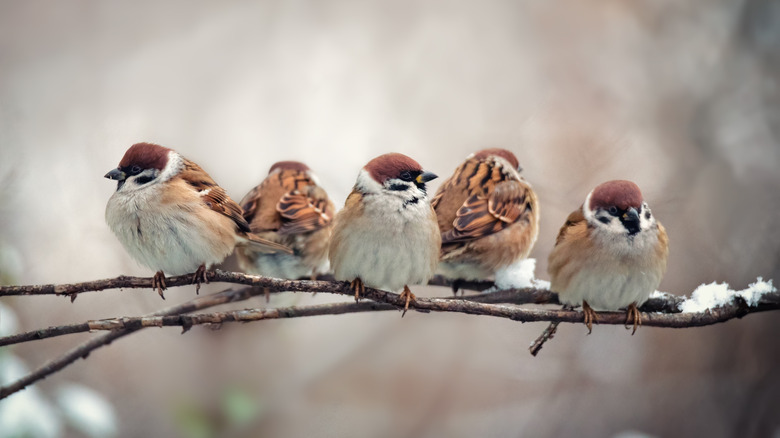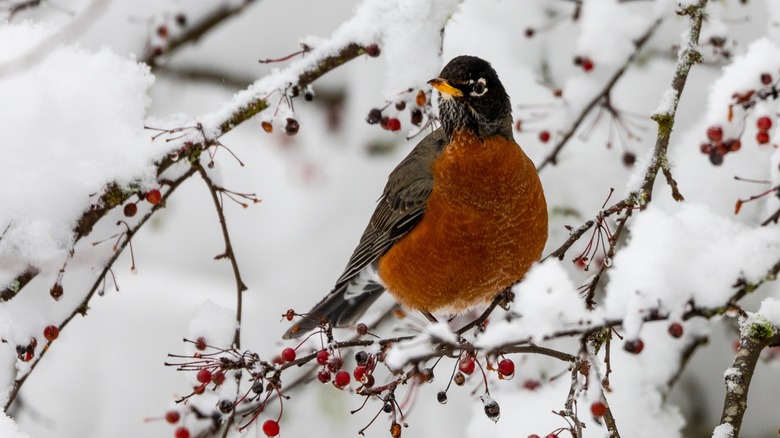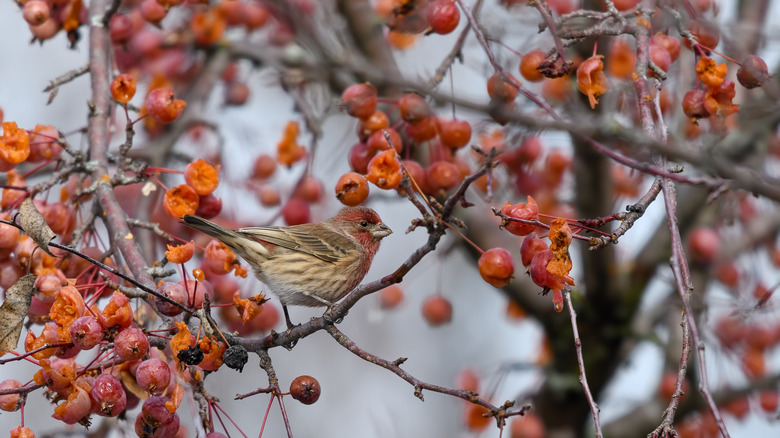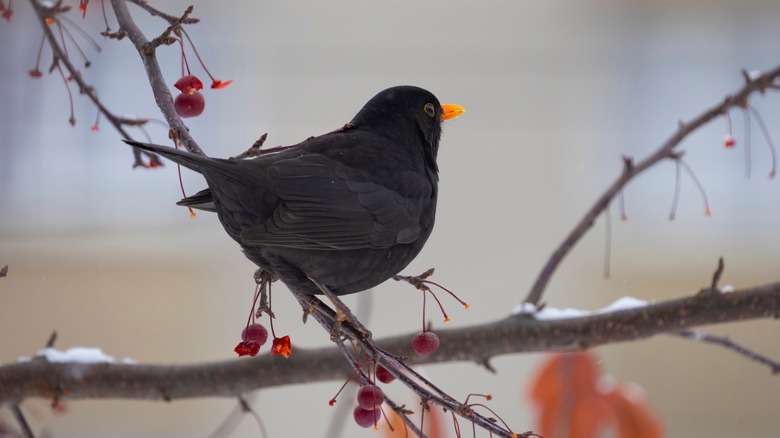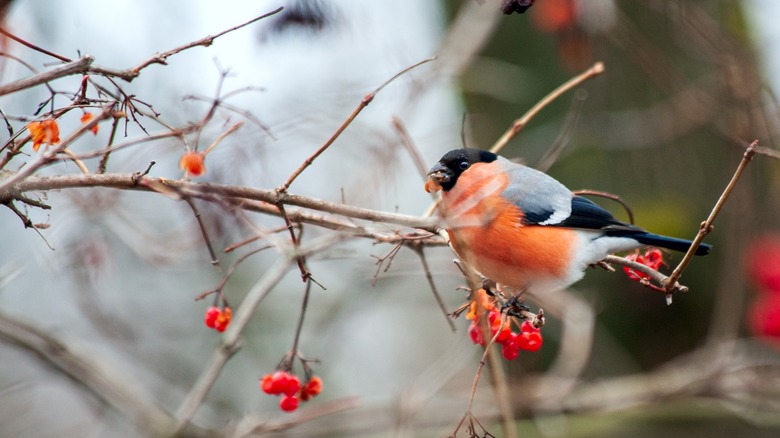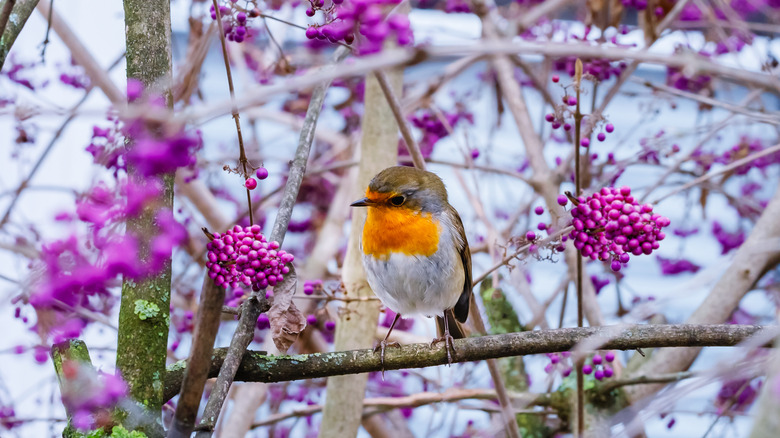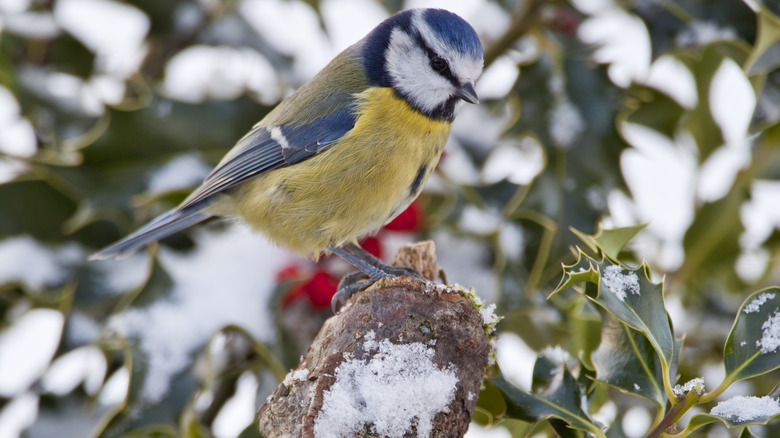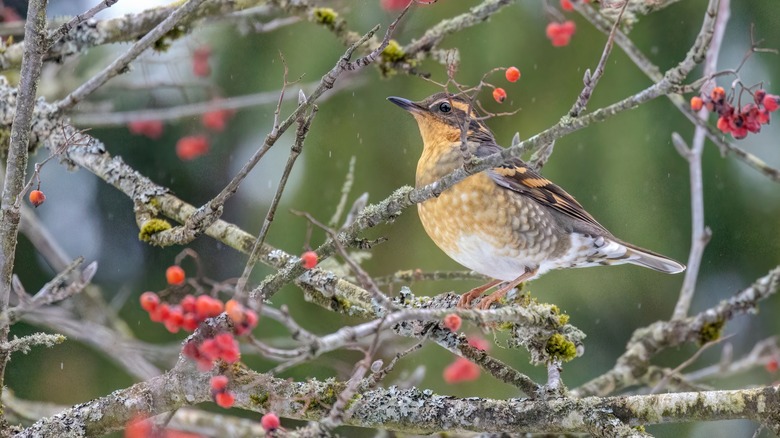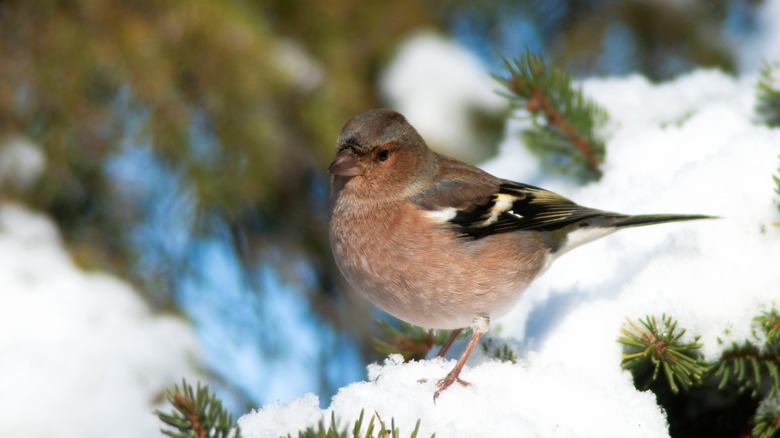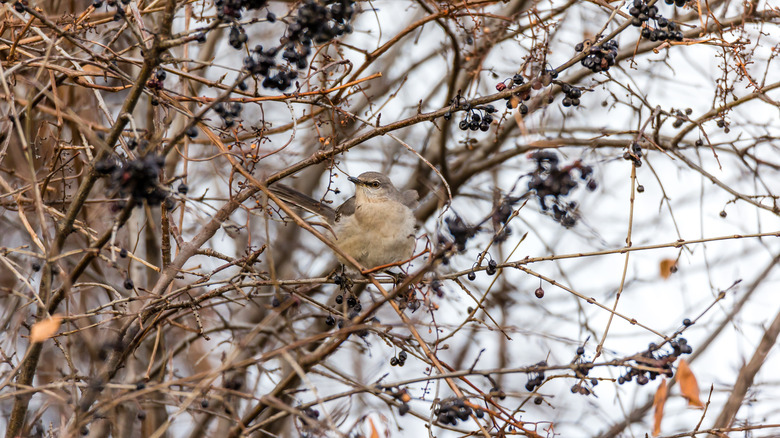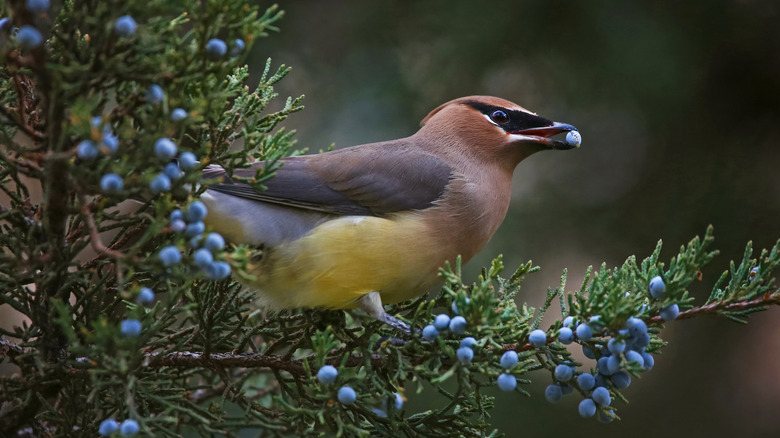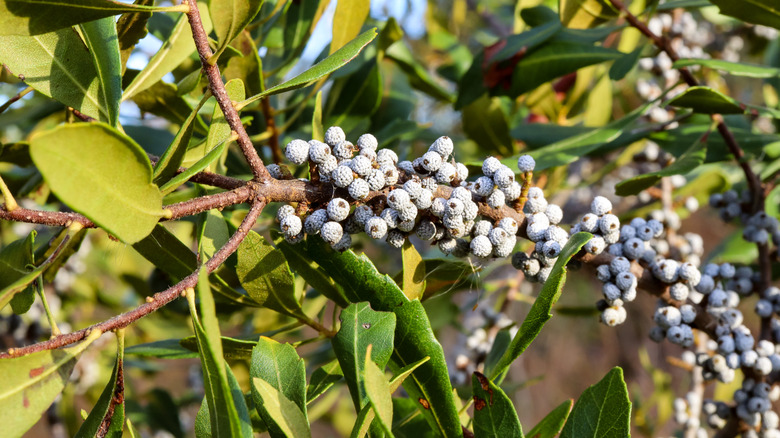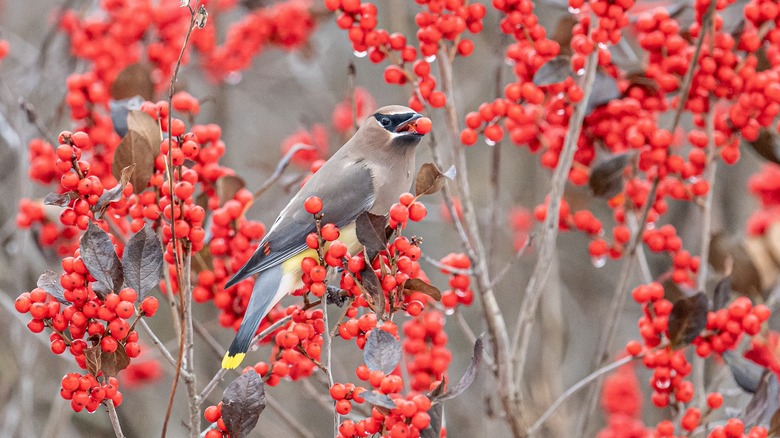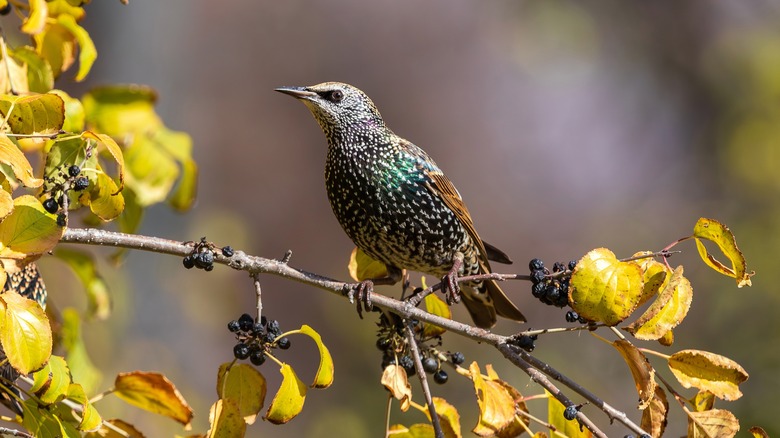13 Shrubs And Trees To Plant In Your Backyard For Bird-Friendly Winter Habitat
As the gardening season starts to wind down in autumn, many gardeners do what they can to help support wildlife in their area. Doing so not only can add some pleasurable viewing to your winter days, but also helps support greater biodiversity in your garden. Birds, in particular, change their habits in winter and even those who remain where they are all year round sometimes struggle to find enough food, warmth and shelter. Planting bird-friendly trees and shrubs that provide a source of food and/or shelter will attract birds to your yard during the winter season.
Even if you're growing trees or shrubs that produce berries, nuts, fruits, or edible cones in the autumn, birds will benefit by eating them to build up fat stores for the cold months ahead. Some shrubs and trees will hold onto their fruits and other edible parts well into the winter, attracting birds who will perch in their branches to eat. These branches also provide protection: from harsh winter winds, from soaking winter rain or wet snow, and from potential predators.
When choosing trees or shrubs to plant, consider their mature size and how they will fit in with other plants and structures. You may want to plant them within sight of your window or enclosed porch so you can enjoy watching birds from inside. Evergreen shrubs provide winter green as well as excellent shelter and food for birds. Also, placing your bird feeders in or near trees or shrubs (as opposed to hanging then on hooks or poles out in the open) provides birds with cover and a sense of safety while they're eating.
Flowering crabapple
The flowering crabapple (Malus spp.) is an excellent landscape tree that is cold hardy in USDA hardiness zones 4 through 8, providing gorgeous pollinator-attracting blossoms in spring and tiny fruits in autumn that linger over winter providing food for wildlife. Some varieties have larger fruits that can be used to make jelly, but these larger fruits tend to fall on the ground where small mammals can eat them. Most crabapple trees produce small fruits that remain on the tree, and the birds love these, as they can shelter safely among branches to feed on them. Crabapple loving birds include cardinals, finches, robins, and bluebirds.
Serviceberry
The serviceberry (Amelanchier alnifolia) is a stunning fruit-bearing tree that will bring more birds to your yard all year, but especially in winter. These resilient trees are great for colder regions and are hardy in zones 2 through 8, depending on variety. They resemble shrubs in their first few years, but over time they grow to look more like trees. This plant known as also has some intriguing common names, including juneberry, saskatoon, and sugarplum. The berries are not only delicious for baking and jam, but are loved by many birds including Northern cardinals, American robins, tufted titmice, Carolina chickadees, blue jays, and American goldfinches.
Hawthorn
The hawthorn (Crataegus spp.) is an ancient tree mentioned often in European folklore. Its spring blossoms are often called "may" and the English expression "going a-maying" refers to young couples going into the forest together to gather the flowering branches. This sturdy, tree is hardy in zones 4 through 8 also sometimes grows as a smaller shrub, and produces abundant tiny berries in autumn. The thorny branches are protective shelter from predators, and are easily navigated by nimble songbirds. The bright red berries (also called "haws") provide a food source well into winter, attracting robins, mockingbirds, Northern cardinals, blackbirds, house wrens, cedar waxwings, and warblers.
Viburnum
There are many kinds of Viburnum, and a fair number of them are excellent berry trees to grow in your yard that birds love. The varieties with berries best known for attracting birds include high bush cranberry, nannyberry bush, and witherod. Various birds drawn to these large shrubs for their red or blue-black berries include bluebirds, robins, cardinals, cedar waxwings, thrushes, various finches, and occasionally ground-feeders like grouse. Some Viburnums are evergreen, but most are deciduous, growing in zones 2 through 9, depending on the species.
Beautyberry
The American beautyberry (Callicarpa americana) is a deciduous shrub that produces magenta berries beginning in late summer. These berries remain on the bush after the leaves drop in autumn, attracting birds in winter. Songbirds like finches, mockingbirds, robins, cardinals, thrashers, and towhees enjoy these berries which provide a good amount of moisture for them in winter. Other wildlife attracted to the colorful berries include raccoons, squirrels, and foxes. This shrub is generally hardy in zones 6 though 10, but with winter protection from wind and a layer of mulch at the roots it may thrive in zone 5.
Holly
With its glossy evergreen leaves and bright berries, American holly (Ilex opaca) is a popular landscaping shrub for colder regions, zones 5 through 9. In some areas it grows as a tall tree, but is often planted as a foundation shrub or hedge. The somewhat prickly leaves make a good habitat for winter bird activity, and the birds who enjoy holly include the American robin, cedar waxwing, hermit thrush, Northern cardinal, and gray catbird. You will need both male and female specimens to successfully grow and care for holly bushes that produce berries.
Cotoneaster
The Cotoneaster (Cotoneaster vulgaris) is a shrub in the rose family that produces abundant flowers in spring (loved by pollinators). But its value for wildlife continues as the season grows colder, when masses of nutritious red berries appear in fall and are gobbled up by migratory birds. Blackbirds, thrushes, and cedar waxwings are particularly attracted to these bright berries. The shrub is hardy in zones 3 through 5 and needs a spot with good drainage to thrive. This shrub is invasive in some states, so check with your local extension service before you plant.
Spruce
Spruce (Picea spp.) trees and shrubs provide lovely blue-green foliage all year, with bright new growth appearing in late summer with tiny cones. The seeds found inside the cones provide a tasty snack for passing birds, and the strong branches and dense needles of these evergreens provide excellent shelter for birds and other wildlife. There's a wide variety of cold-hardy spruce shrub and tree cultivars in a range of sizes, most of them hardy in zones 3 thorough 8. Birds that feed on the seeds of spruce cones include chickadees, nuthatches, juncoes, and finches.
Elderberry
There are elderberry trees and shrubs: the preferred cultivar for North America is American elderberry (Sambuca canadensis), hardy in USDA Zones 4 through 8, which grows up to 12 feet high and is a manageable size for most garden landscapes. These large shrubs produce delicate masses of tiny cream-colored blossoms in spring, attracting many pollinators. Starting in late summer, small, nutritious, dark-purple berries appear, and birds begin flocking to them. Birds that enjoy eating elderberries include warblers, cedar waxwings, thrushes, kinglets, American robins, Northern cardinals, gray catbirds, and many others.
Juniper
The frosty blue berries of the juniper shrub (Juniperus spp.) are an important winter food source for a wide range of birds, including grouse, wild turkeys, evening grosbeaks, and Eastern bluebirds. Junipers aren't hard to grow and are very cold hardy in zones 2 through 7, but there are some caveats to be aware of before planting them. Only female shrubs produce berries, and male shrubs are needed to pollinate for berry production. These shrubs are highly flammable in dry weather, so don't plant them near your house or other wood structures. Also, they should not be planted near apple or crabapple trees, due to their susceptibility to cedar-apple rust.
Bayberry
The bayberry (Myrica pensylvanica) is an evergreen shrub well known for the fresh scent of its leaves and berries; the berries are used to scent candles. Female bayberry shrubs produce berries, and as with holly, you must also have male plants present for berries to form. The waxy grey berries of the Northern bayberry (also known as wax myrtle) appear late in the season, and are full of nutrients that birds love, especially chickadees, yellow-rumped warblers, catbird, bluebirds, and others. The dense branching of these shrubs forms a thicket that provides birds with winter shelter. This shrub needs no pruning, grows no more than 10 feet tall, and is hardy in zones 3 through 7.
Winterberry
The pretty red berries of the winterberry shrub (Ilex verticillata), born thickly on straight stems, are often used for holiday decor, but they are also a magnet for the songbirds who enjoy snacking on them. Technically the winterberry is a type of holly, but is not evergreen (the leaves drop off before winter). This robust holly is hardy in zones 3 through 9. Still, various birds flock to the dense branches in winter to feast on their fruit, including American robins, woodpeckers, bluebirds, and cedar waxwings. Winterberry shrubs can grow up to 15 feet tall and 10 feet wide, and thrive best in partial to full sun.
Chokeberry
The black chokeberry shrub (Aronia melanocarpa) produces juicy, nutritious blue-black berries well-loved by many birds, including cedar waxwings, tufted titmice, and chickadees. It has dense branching that also attracts birds seeking winter protection. It is hardy in zones 3 through 9 and tolerates moist planting areas. The black chokeberry also has colorful autumn foliage, and pollinator-friendly flowers in spring, making it an attractive four season plant. It is an easy shrub to grow — suitable for sun or shade — that is beneficial to wildlife and will increase biodiversity in your garden.
